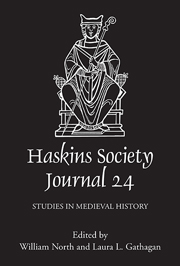Book contents
- Frontmatter
- Contents
- List of Figures
- Editor's Note
- Abbreviations
- 1 ‘Those Five Knights which you Owe me in Respect of your Abbacy’. Organizing Military Service after the Norman Conquest: Evesham and Beyond
- 2 Voluntary Ascetic Flagellation: From Local to Learned Traditions
- 3 The Material and the Visual: Objects and Memories in the Historia ecclesiastica of Orderic Vitalis
- 4 Anonymus Vaticanus: Another Source for the Normans in the South?
- 5 Christian Community and the Crusades: Religious and Social Practices in the De expugnatione Lyxbonensi
- 6 Godric of Finchale's Canora Modulatio: The Auditory and Visionary Worlds of a Twelfth-Century Hermit
- 7 Did Portugal Have a Twelfth-Century Renaissance?
- 8 Internal and External Audiences: Reflections on the Anglo-Saxon Archive of Bury St Edmunds Abbey in Suffolk
2 - Voluntary Ascetic Flagellation: From Local to Learned Traditions
Published online by Cambridge University Press: 05 December 2013
- Frontmatter
- Contents
- List of Figures
- Editor's Note
- Abbreviations
- 1 ‘Those Five Knights which you Owe me in Respect of your Abbacy’. Organizing Military Service after the Norman Conquest: Evesham and Beyond
- 2 Voluntary Ascetic Flagellation: From Local to Learned Traditions
- 3 The Material and the Visual: Objects and Memories in the Historia ecclesiastica of Orderic Vitalis
- 4 Anonymus Vaticanus: Another Source for the Normans in the South?
- 5 Christian Community and the Crusades: Religious and Social Practices in the De expugnatione Lyxbonensi
- 6 Godric of Finchale's Canora Modulatio: The Auditory and Visionary Worlds of a Twelfth-Century Hermit
- 7 Did Portugal Have a Twelfth-Century Renaissance?
- 8 Internal and External Audiences: Reflections on the Anglo-Saxon Archive of Bury St Edmunds Abbey in Suffolk
Summary
Self-flagellation in the twenty-first century seems more masochistic than religious, and spirituality today has little place for the ascetical use of a whip or other instruments of torture. Yet the practice will not quite disappear. We see it in film, and not just in medieval contexts such as Ingmar Bergman's The Seventh Seal (1957) or Monty Python and the Holy Grail (1975), but also in contemporary manifestations such as Silas, the renegade Opus Dei member in Dan Brown's novel The Da Vinci Code (2003), or the video images of Shi'ite pilgrims flagellating themselves with chains and slashing their foreheads with swords while they commemorate 'Ashura.
Such forms of ascetic practice have long been studied in their Latin Christian context. According to the traditional narrative, which this study attempts to destabilize, self-flagellation was an ancient monastic expression of penance. How ancient has been debated, but certainly by the eleventh century it is well documented among Italian hermits. In the thirteenth century it would have entered lay society as part of the ‘monasticization of the laity’, the top-down process by which religious elites impose their values on the masses. In the words of André Vauchez, the preeminent authority on lay spirituality, ‘The confraternities of penitents and flagellants were clearly animated by the desire to appropriate the spiritual resources of monasticism…. The most telling example of this was flagellation — a monastic practice which some lay people in the thirteenth century appropriated in order to win the rewards associated with it.
- Type
- Chapter
- Information
- The Haskins Society Journal 242012 Studies in Medieval History, pp. 41 - 62Publisher: Boydell & BrewerPrint publication year: 2013



